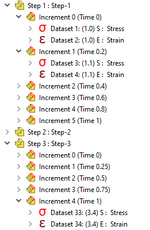Gov45
Automotive
- May 8, 2024
- 14
I wanted to do a fatigue analysis. The initial stresses I obtain is above the yield limit. There is non-linearity due to contacts and plasticity. I have few queries as below.
Stress Based Approach
For high cycle fatigue I am using a (S-N) approach because the linear stresses are below 70% of yield and in the elastic part of the material curve. I clearly understand this.
Strain Based Approach
When the linear stresses are over yield this is where I am still unclear and have questions.
1. Should I always use a strain based approach when the stress is over yield?
2. Should I use the above linear stresses, over yield, with an elastic plastic correction (Neuber).
3. Should I use non-linear stress results with no elastic plastic correction.
Stress Based Approach
For high cycle fatigue I am using a (S-N) approach because the linear stresses are below 70% of yield and in the elastic part of the material curve. I clearly understand this.
Strain Based Approach
When the linear stresses are over yield this is where I am still unclear and have questions.
1. Should I always use a strain based approach when the stress is over yield?
2. Should I use the above linear stresses, over yield, with an elastic plastic correction (Neuber).
3. Should I use non-linear stress results with no elastic plastic correction.



